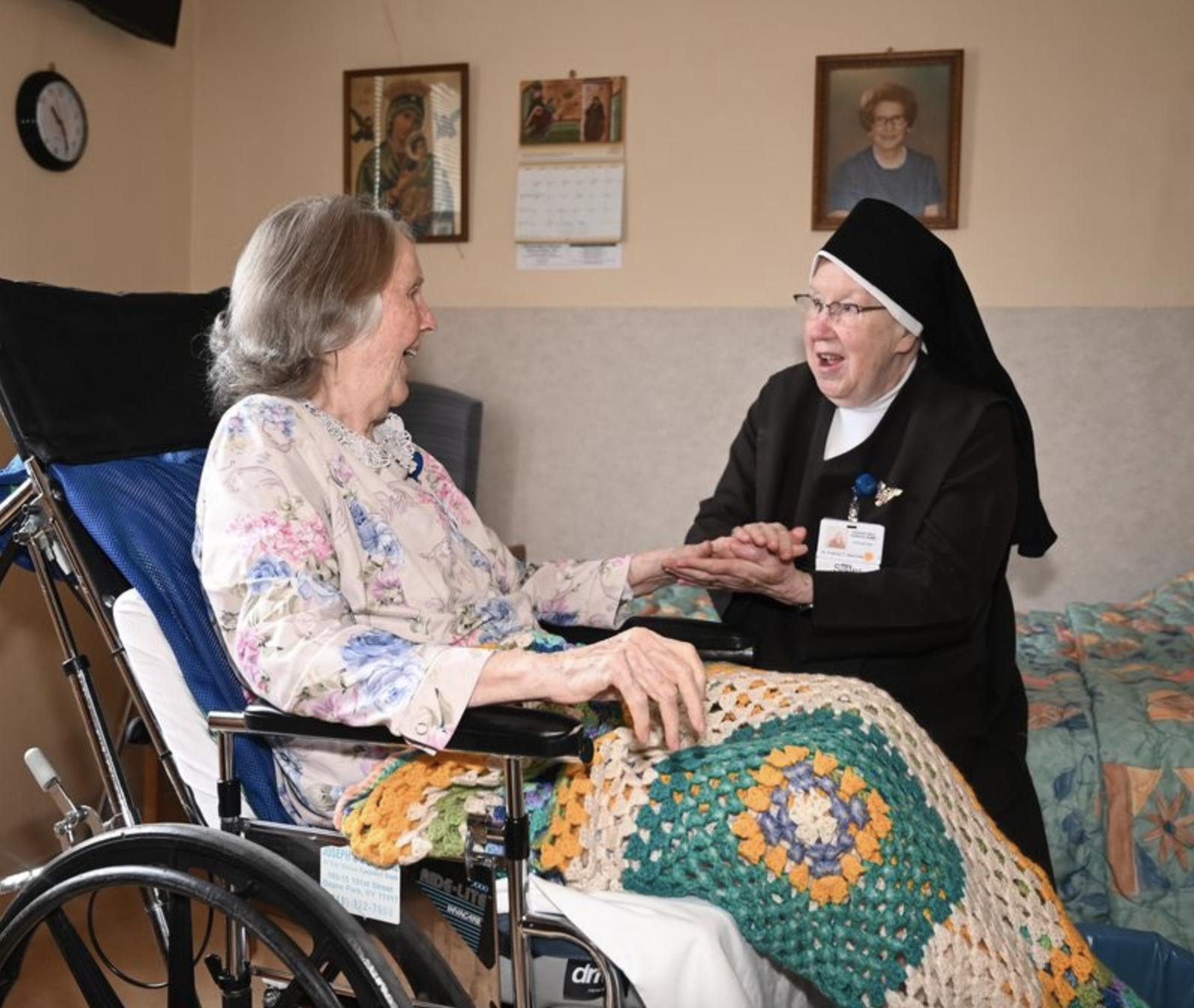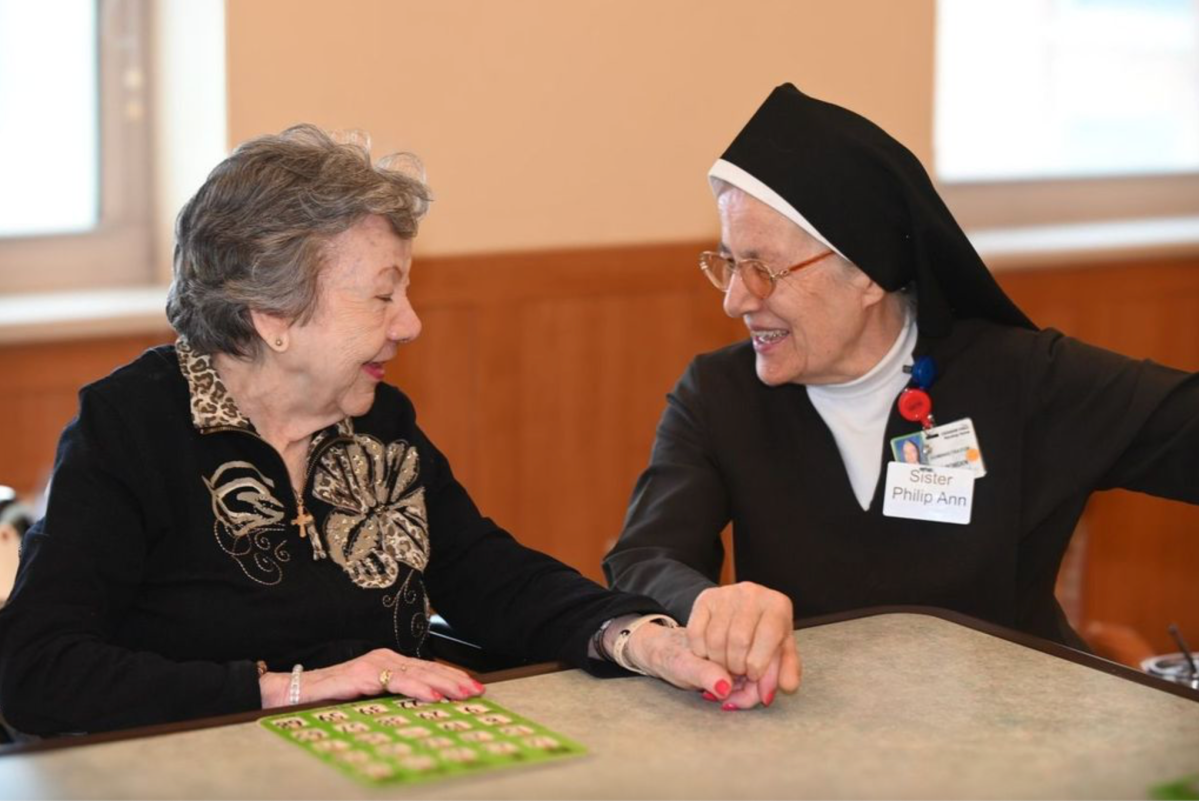The Carmelite Sisters for the Aged and Infirm are working to preserve a care model, rooted in love, for a growing older adult population.
Since 1971, Ozanam Hall Nursing Home in Bayside has sponsored the Carmelite Sisters congregation to provide skilled, well-rounded care to seniors of all faiths through a traditional Catholic healthcare model. It is currently home to over 350 senior residents receiving around-the-clock care in their final years.
Among the hundreds of employees are fifteen nuns, some visiting from other countries, who reside on the top floor. While their professional occupations include registered nurses, social workers and administrators, they are united by their pledge of poverty and service to others. Those working in the system say that their presence is a guiding force for the residents going through the physical and mental challenges of aging.
The Carmelite System is currently exploring routes to preserve the footprint of the Catholic Church and grow the Catholic model of healthcare. In the process, they hope to continue serving people in need while adhering to their motto: “The difference is love.”
“We continue to carry on the values and charisms of the Carmelite sisters to ensure that we really have a focus on human dignity, especially as people age,” said Patrica K. Gathers, President and CEO of The Carmelite System. She began working in Catholic healthcare in 2001, and was inspired to become a Mercy Associate.

She says that one key difference between Carmelite nursing homes and others is an emphasis on comprehensive palliative care measures to address the spiritual and emotional pain that comes up towards the end of one’s life. The goal is to allow the long-term residents to lead a dignified life as they become infirm, which includes offering private rooms, a range of daily activities for engagement, and spiritual care for people of all faiths.
The Carmelite Sisters congregation was founded in 1929 by Mother Angeline McCrory, who also wanted to establish a care model for the middle class. She previously served as a superior of the Little Sisters of the Poor in the Bronx but was moved by the need to serve elderly people of all socioeconomic classes.
Today, the Carmelite congregation is uniquely positioned as the only post-acute Catholic-sponsored entity in the country. It offers nursing homes and assisted living without being tied to a hospital system, which has a very different business model. The congregation is found in seven states with 13 entities, including one in Ireland.
“We want the residents to make sure that they understand that we are in their home, and we’re here to serve them,” said Gathers, giving an example of, “I don’t say I’m the CEO, I serve in the capacity of the CEO, I’m here to serve.”
While the number of nuns is dwindling—only 115 sisters remain in the Carmelite congregation according to leaders—the quality of care they deliver to patients and fellow staff members remains unwavering. The decline in numbers can be attributed to more opportunities for women to make an impact today than there were decades ago.
A 2014 report from the Center for Applied Research in the Apostolate found that only 1% of nuns today are under 40 and the average age of a sister is 80 years old. And since 1965 there has been a 76 percent drop in sisters around the country with less than a thousand anticipated to be left by 2042.

“We all have a method of catering to others and my method is be available, be public and get the work done,” said Sister Philip Ann, Administrator at Ozanam Hall. “But everybody tries to give the best care they can.”
Sister Philip arrived in Queens in 2015 after working from locations in Boston, Cincinnati, Columbus and other boroughs in the city over the years. Originally from Ireland, she took a vow of poverty at 22 and has since worked in the Carmelite System in various roles, including registered nurse and director of nurses.
“We all inspire each other,” she said about her current role in Ozanam Hall. “One person’s loving attention for a resident inspires compassion for another person. When one of us is having a bad day, another pulls them out of it.”
During the early days of the pandemic, when nursing homes had significantly high rates of infection and death, the sisters ramped up their efforts. Despite their ages and proximity putting them at a heightened risk, they continued their roles and filled in the gaps created by a shrinking staff.
Before the pandemic government assistance came in, the St. Patrick’s Home in the Bronx was at risk of closing due to a significant decrease in the census. In an effort to save it, the Carmelite Sisters congregation gave $9 million of their own funds to keep the facility from shuttering.

“They took of their own resources, their own future pension money to take care of their congregation, and they invested it to ensure that our homes were able to survive during the pandemic,” Gathers recalled. “I think that that’s a beautiful thing.”
Gathers says it’s not the first time the nuns have used ingenuity and pooled resources to serve others. The history of the Carmelite Sisters is steeped with similar stories of women’s innovation and selflessness. This congregation was born during a period when the sisters were given male names so that they would be taken more seriously in a male-dominated society.
Gathers says that her goal now is to maintain a sound financial and business model so that the sisters do not need to underwrite their ministry in the future, even if their compassionate natures incline them to. She hopes that the Catholic business model remains viable and continues to survive amid the changes in the modern world.
“This has been a women-led business since 1929 when it was unheard of. They really have made a material impact across this country that people don’t even necessarily understand,” said Gathers. “They pulled things together, and they just did it on faith, and a lot of prayers and a lot of grit not asking for anything in return. And that’s why I’m personally committed to trying to make sure that these assets are preserved.”





































